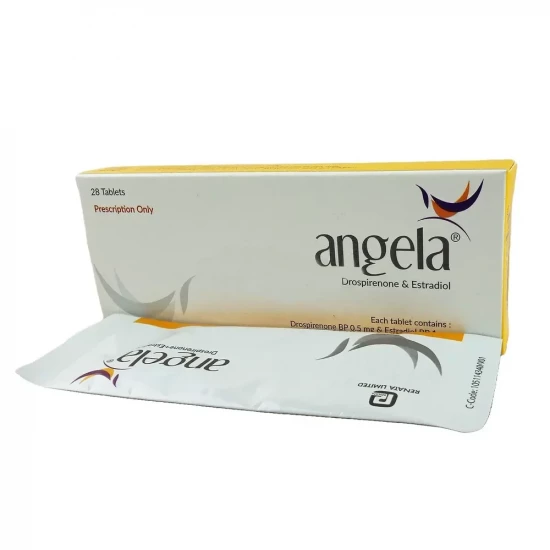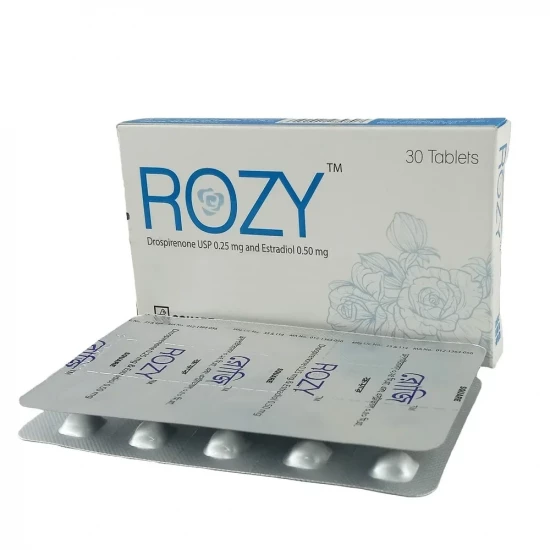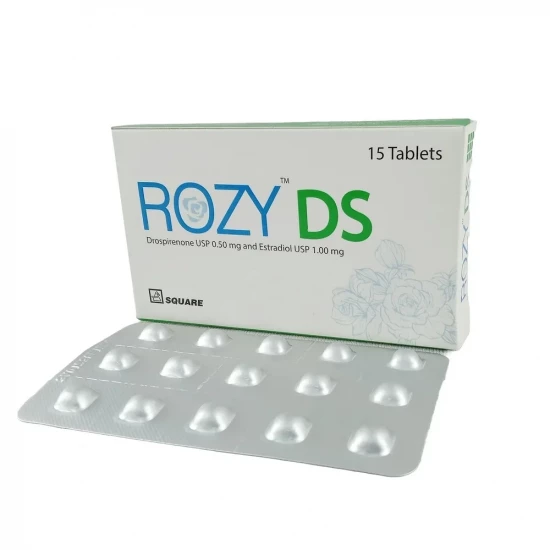
✔ 100% Authentic Product
👁️ Currently Viewing 313
Hormone replacement therapy (HRT) for the treatment of:
- Climacteric syndrome in postmenopausal women, including vasomotor symptoms (such as hot flushes and sweating attacks), sleep disorders, depressed moods, nervousness, and atrophic urogenital conditions caused by deficient endogenous estrogen production due to natural menopause, hypogonadism, castration, or primary ovarian failure in women with an intact uterus.
- Prevention of postmenopausal osteoporosis.
Discount
Price: ৳ 659
MRP:
৳
672
2%
Off

100% Genuine Products, Guaranteed

Safe & Secure Payments, Always

Fast, Secure & Efficient Delivery

Proper Packaging
 Cash on Delivery - All over Bangladesh
Cash on Delivery - All over Bangladesh Regular Delivery - 12-24 Hours, Dhaka City* Charge Tk.39-59
Regular Delivery - 12-24 Hours, Dhaka City* Charge Tk.39-59 Regular Delivery - 24-48 Hours, Other Cities* Charge Tk.99-110
Regular Delivery - 24-48 Hours, Other Cities* Charge Tk.99-110
 ফ্রি ডেলিভারিঃ - ৯৯৯ টাকা+ অর্ডারে, ঢাকা
শহরে
ফ্রি ডেলিভারিঃ - ৯৯৯ টাকা+ অর্ডারে, ঢাকা
শহরে ফ্রি ডেলিভারিঃ - ২৯৯৯ টাকা+ অর্ডারে, ঢাকার
বাহিরে
ফ্রি ডেলিভারিঃ - ২৯৯৯ টাকা+ অর্ডারে, ঢাকার
বাহিরে
100% Genuine Products, Guaranteed
Safe & Secure Payments, Always
Fast, Secure & Efficient Delivery
Proper Packaging
 Cash on Delivery - All over Bangladesh
Cash on Delivery - All over Bangladesh Regular Delivery - 12-24 Hours, Dhaka City* Charge Tk.39-59
Regular Delivery - 12-24 Hours, Dhaka City* Charge Tk.39-59 Regular Delivery - 24-48 Hours, Other Cities* Charge Tk.99-110
Regular Delivery - 24-48 Hours, Other Cities* Charge Tk.99-110 ফ্রি ডেলিভারিঃ - ৯৯৯ টাকা+ অর্ডারে, ঢাকা
শহরে
ফ্রি ডেলিভারিঃ - ৯৯৯ টাকা+ অর্ডারে, ঢাকা
শহরে ফ্রি ডেলিভারিঃ - ২৯৯৯ টাকা+ অর্ডারে, ঢাকার
বাহিরে
ফ্রি ডেলিভারিঃ - ২৯৯৯ টাকা+ অর্ডারে, ঢাকার
বাহিরে
✅ Description:
Angela Tablet contains 17β-estradiol, which is chemically and biologically identical to the natural human estrogen (E2), and drospirenone (DRSP), a synthetic progestogen. Estradiol serves as a hormone replacement both during and after menopause, while drospirenone helps regulate bleeding and prevents endometrial hyperplasia that may result from estrogen therapy.
Effects of Estradiol:
The decline in ovarian function during menopause causes a significant reduction in estrogen and progesterone levels, leading to menopausal symptoms such as vasomotor instability and organic changes. Hormone replacement therapy (HRT) helps relieve these symptoms. Among all physiological estrogens, estradiol (E2) has the strongest estrogenic activity, showing the highest affinity for estrogen receptors.
Primary target organs of estrogen include the uterus, hypothalamus, pituitary gland, vagina, breasts, and bones (osteoclasts).
Other notable effects of estrogens include reducing insulin and blood glucose levels, producing local vasoactive responses through receptor-mediated actions, and receptor-independent effects on vascular smooth muscle. Estrogen receptors are also present in the heart and coronary arteries. Oral administration of natural estrogens can be beneficial in some hypercholesterolemia cases, enhancing liver metabolism and promoting favorable lipid profile changes.
✔️ Dosage and Administration
How to Start:
Women who are not currently on estrogen therapy, or those switching from a continuous combined HRT, may start treatment at any time. Patients changing from a cyclic or sequential HRT regimen should complete their current cycle before beginning this medication.
Dosage:
Take one tablet daily, as prescribed.
Missed Dose:
If a tablet is missed, take it as soon as you remember. If more than 24 hours have passed, skip the missed tablet—do not double the dose. Missing several tablets may lead to breakthrough bleeding.
রেজিস্টার্ড চিকিৎসকের পরামর্শ মোতাবেক ঔষধ সেবন করুন।
Administration:
Each pack provides 28 days of continuous treatment. Start the next pack immediately after finishing the previous one without any break. Swallow the tablet whole with water, with or without food, preferably at the same time each day. For postmenopausal therapy, use the lowest effective dose for the shortest possible duration to relieve symptoms.
✔️ Drug Interactions
The clinical effectiveness of Angela Tablet may be reduced by medications that induce hepatic enzymes, which can increase the clearance of sex hormones. Such enzyme-inducing drugs include hydantoins, barbiturates, primidone, carbamazepine, and rifampicin, with possible effects also seen with oxcarbazepine, topiramate, felbamate, and griseofulvin.
Enzyme induction typically peaks after 2–3 weeks of therapy and may persist for at least 4 weeks after stopping the inducing medication.
In some cases, reduced estradiol (E2) levels have been reported with certain antibiotics (e.g., penicillins and tetracyclines).
The metabolism of drospirenone (DRSP) occurs independently of the cytochrome P450 system, so CYP inhibitors are unlikely to significantly affect its breakdown. However, CYP3A4 inhibitors such as cimetidine, ketoconazole, and others may reduce the metabolism of estradiol.
Interaction with Alcohol:
Acute alcohol intake during HRT use may cause elevated estradiol levels.
✔️ Angela Tablet should not be used in patients with any of the following conditions:
- Known or suspected malignancies or premalignant conditions influenced by sex steroids
- History or presence of liver tumors (benign or malignant)
- Severe hepatic disease
- Current or past severe renal disease (until renal function returns to normal)
- Acute arterial thromboembolism (e.g., myocardial infarction, stroke)
- Active deep vein thrombosis or history of thromboembolic disorders
- High risk of venous or arterial thrombosis
- Severe hypertriglyceridemia
- Pregnancy or breastfeeding
- Hypersensitivity to estradiol, drospirenone, or any of the excipients
✔️ Contraindications and Precautions for Hormone Replacement Therapy (HRT)
Hormone replacement therapy (HRT) must not be initiated in women presenting with any of the following conditions. Treatment should be discontinued immediately if any of these arise during HRT use:
- Undiagnosed abnormal genital bleeding
- Known or suspected breast cancer
- Known or suspected premalignant or malignant conditions influenced by sex steroids
The increased risk of breast cancer associated with HRT typically diminishes within a few years after stopping treatment. HRT can also increase mammographic density, potentially complicating the radiological detection of breast cancer in some women.
Endometrial Cancer
Prolonged exposure to unopposed estrogens may lead to endometrial hyperplasia or endometrial carcinoma. The inclusion of drospirenone (DRSP) counteracts this risk by opposing estrogen-induced endometrial proliferation.
Liver Tumors
In rare cases, benign or malignant liver tumors have been reported with hormonal therapies such as HRT. In isolated cases, these tumors have resulted in life-threatening intra-abdominal hemorrhage.
✔️ Side Effects
The most commonly reported adverse reactions to Ethinylestradiol and Drospirenone include:
- Breast pain
- Genital tract bleeding
- Gastrointestinal or abdominal pain
✔️ Overdose Effects
Acute toxicity is unlikely, even with ingestion of multiple therapeutic doses.
Clinical studies have shown that doses up to 100 mg of drospirenone and 4 mg of estradiol were well tolerated.
Symptoms of overdose are expected to be mild and may include nausea, vomiting, or withdrawal bleeding.
✔️ Use in Special Populations
Children and Adolescents:
Not indicated for use in this population.
Geriatric Patients:
No specific dose adjustment is required for elderly women.
Hepatic Impairment:
Drospirenone is generally well tolerated in mild to moderate hepatic impairment but is contraindicated in severe hepatic disease.
Renal Impairment:
Slight increases in drospirenone exposure may occur in women with mild to moderate renal impairment, but this is not clinically significant. However, the drug is contraindicated in patients with severe renal disease.
✔️ Pregnancy and Lactation
Contraindicated.
Ethinylestradiol and Drospirenone must not be used during pregnancy or breastfeeding. If pregnancy occurs while taking this medication, treatment should be stopped immediately.
Small amounts of drospirenone may pass into breast milk.
✔️ Precautions and Warnings
Before initiating therapy, the physician must carefully evaluate the individual's benefit–to–risk ratio, considering all relevant health conditions and risk factors.
HRT should be discontinued immediately in any of the following situations:
Onset of migrainous or unusually severe headaches that occur for the first time or indicate possible cerebrovascular occlusion
Recurrence of cholestatic jaundice or pruritus first experienced during pregnancy or previous sex steroid therapy
Appearance of symptoms suggestive of thrombotic events
If new conditions or risk factors emerge during therapy, a reassessment of benefits and risks must be performed. HRT should not continue if the risk outweighs the therapeutic benefit.
Venous Thromboembolism (VTE)
Clinical and epidemiological studies have shown an increased risk of VTE (e.g., deep vein thrombosis or pulmonary embolism) with HRT use.
Prescribers should carefully assess the benefit–risk profile for women with any predisposing factors, including:
Personal or family history of VTE
Severe obesity
Increasing age
The role of varicose veins in VTE risk remains uncertain.
The risk may also rise with prolonged immobilization, major surgery, or severe trauma. Temporary discontinuation of HRT should be considered in such cases.
✔️ Storage:
Keep below 30°C temperature, away from light & moisture. Keep out of the reach of children.
⚠️Disclaimer:
At ePharma, we’re committed to providing accurate and accessible health information. However, all content is intended for informational purposes only and should not replace medical advice from a qualified physician. Please consult your healthcare provider for personalized guidance. We aim to support, not substitute, the doctor-patient relationship.








